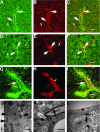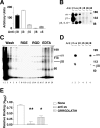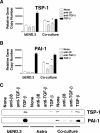Integrin alpha(v)beta8-mediated activation of transforming growth factor-beta by perivascular astrocytes: an angiogenic control switch
- PMID: 15920172
- PMCID: PMC1602409
- DOI: 10.1016/s0002-9440(10)62497-2
Integrin alpha(v)beta8-mediated activation of transforming growth factor-beta by perivascular astrocytes: an angiogenic control switch
Abstract
Brain hemorrhage is a severe complication of both neoplastic and nonneoplastic brain disease. Mice deficient in the alpha(v)beta8 integrin display defective brain vessel formation resulting in hemorrhage and perinatal death, but the mechanism of brain hemorrhage is unknown. Because the alpha(v)beta8 integrin is expressed by astrocytes and not expressed by endothelium, paracrine interactions between astrocytes and endothelial cells could contribute to the maintenance of brain vessel integrity. We have investigated the mechanisms underlying astrocytic-endothelial paracrine signaling and have found that integrin-mediated activation of transforming growth factor (TGF)-beta by astrocytes influences endothelial cell function. Thus, we identified the integrin alpha(v)beta8 in human perivascular glial cell processes surrounding developing blood vessels. Human astrocytic alpha(v)beta8 was a major cell surface receptor for latent TGF-beta, and alpha(v)beta8-dependent activation of TGF-beta was the major mechanism of TGF-beta activation in primary cultures of astrocytes or freshly dissociated fetal brain cells. This activation of TGF-beta was sufficient to inhibit endothelial migration in fibrin gels and to alter expression of genes affecting proteolytic and angiogenic pathways. Taken together, our data suggest that astrocytic alpha(v)beta8 acts as a central regulator of brain vessel homeostasis through regulation of TGF-beta activation and expression of TGF-beta-responsive genes that promote vessel differentiation and stabilization, most notably plasminogen activator inhibitor-1 and thrombospondin-1.
Figures







Similar articles
-
Neuropilin 1 balances β8 integrin-activated TGFβ signaling to control sprouting angiogenesis in the brain.Development. 2015 Dec 15;142(24):4363-73. doi: 10.1242/dev.113746. Epub 2015 Nov 19. Development. 2015. PMID: 26586223 Free PMC article.
-
Overexpression of integrin beta 5 enhances the paracrine properties of circulating angiogenic cells via Src kinase-mediated activation of STAT3.Arterioscler Thromb Vasc Biol. 2010 Jul;30(7):1398-406. doi: 10.1161/ATVBAHA.110.206086. Epub 2010 Apr 29. Arterioscler Thromb Vasc Biol. 2010. PMID: 20431064
-
The β8 integrin cytoplasmic domain activates extracellular matrix adhesion to promote brain neurovascular development.Development. 2022 Mar 15;149(6):dev200472. doi: 10.1242/dev.200472. Epub 2022 Mar 18. Development. 2022. PMID: 35217866 Free PMC article.
-
Use of Cre-lox technology to analyze integrin functions in astrocytes.Methods Mol Biol. 2012;814:555-70. doi: 10.1007/978-1-61779-452-0_37. Methods Mol Biol. 2012. PMID: 22144332 Review.
-
Integrin-mediated transforming growth factor-beta activation, a potential therapeutic target in fibrogenic disorders.Am J Pathol. 2009 Oct;175(4):1362-70. doi: 10.2353/ajpath.2009.090393. Epub 2009 Sep 3. Am J Pathol. 2009. PMID: 19729474 Free PMC article. Review.
Cited by
-
Signaling Role of Pericytes in Vascular Health and Tissue Homeostasis.Int J Mol Sci. 2024 Jun 15;25(12):6592. doi: 10.3390/ijms25126592. Int J Mol Sci. 2024. PMID: 38928298 Free PMC article. Review.
-
Regulation of the Bioavailability of TGF-β and TGF-β-Related Proteins.Cold Spring Harb Perspect Biol. 2016 Jun 1;8(6):a021907. doi: 10.1101/cshperspect.a021907. Cold Spring Harb Perspect Biol. 2016. PMID: 27252363 Free PMC article. Review.
-
Cross-talk between blood vessels and neural progenitors in the developing brain.Neuronal Signal. 2018 Mar 30;2(1):NS20170139. doi: 10.1042/NS20170139. eCollection 2018 Mar. Neuronal Signal. 2018. PMID: 32714582 Free PMC article. Review.
-
Pericytes as targets in hereditary hemorrhagic telangiectasia.Front Genet. 2015 Feb 13;6:37. doi: 10.3389/fgene.2015.00037. eCollection 2015. Front Genet. 2015. PMID: 25763012 Free PMC article. Review.
-
TGF-β as a Key Modulator of Astrocyte Reactivity: Disease Relevance and Therapeutic Implications.Biomedicines. 2022 May 23;10(5):1206. doi: 10.3390/biomedicines10051206. Biomedicines. 2022. PMID: 35625943 Free PMC article. Review.
References
-
- Ballabh P, Braun A, Nedergaard M. The blood-brain barrier: an overview: structure, regulation, and clinical implications. Neurobiol Dis. 2004;16:1–13. - PubMed
-
- Pardridge WM. Blood-brain barrier biology and methodology. J Neurovirol. 1999;5:556–569. - PubMed
-
- Martin JS, Dickson MC, Cousins FM, Kulkarni AB, Karlsson S, Akhurst RJ. Analysis of homozygous TGF beta 1 null mouse embryos demonstrates defects in yolk sac vasculogenesis and hematopoiesis. Ann NY Acad Sci. 1995;752:300–308. - PubMed
-
- van den Driesche S, Mummery CL, Westermann CJ. Hereditary hemorrhagic telangiectasia: an update on transforming growth factor beta signaling in vasculogenesis and angiogenesis. Cardiovasc Res. 2003;58:20–31. - PubMed
Publication types
MeSH terms
Substances
Grants and funding
LinkOut - more resources
Full Text Sources
Other Literature Sources

